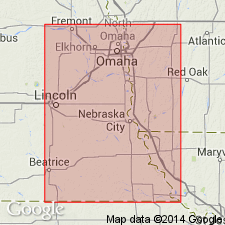
- Usage in publication:
-
- Ervine Creek limestone bed
- Modifications:
-
- Original reference
- Dominant lithology:
-
- Limestone
- AAPG geologic province:
-
- Nemaha anticline
- Forest City basin
Summary:
Pg. 40, 43, 49, 50. Ervine Creek limestone bed of Deer Creek limestone member of Shawnee formation. Is top unit in Deer Creek limestone. It is 24 to 28 feet thick in southeastern Nebraska, 22.5 feet thick in southwestern Iowa, 16 feet thick at Forbes, Missouri, and 12 feet thick in Kansas Valley east of Topeka, Kansas. Its thickest and best-known development is near Louisville, Nebraska. Overlies Mission Creek shale and underlies Jones Point shale, the basal bed of Calhoun shale. Age is Late Pennsylvanian (Missouri age). Report includes cross sections, measured sections, geologic maps, stratigraphic tables.
Named from Ervine Creek, northeast of Union, Cass Co., southeastern NE.
Source: US geologic names lexicon (USGS Bull. 896, p. 697); GNC KS-NE Pennsylvanian Corr. Chart, sheet 1, Oct. 1936; supplemental information from GNU records (USGS DDS-6; Denver GNULEX).
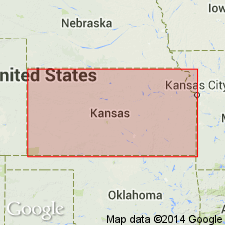
- Usage in publication:
-
- Ervine Creek limestone member
- Modifications:
-
- Contact revised
- AAPG geologic province:
-
- Nemaha anticline
- Forest City basin
Summary:
Ervine Creek limestone member of Deer Creek limestone of Shawnee group. Excluded from Calhoun shale the Jones Point shale and the overlying limestone and included them in Deer Creek limestone. Age is Late Pennsylvanian (Virgil).
Source: US geologic names lexicon (USGS Bull. 896, p. 697); GNC KS-NE Pennsylvanian Corr. Chart, sheet 2, Oct. 1936.
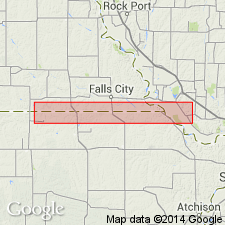
- Usage in publication:
-
- Ervine Creek limestone member
- Modifications:
-
- Contact revised
- AAPG geologic province:
-
- Forest City basin
- Nemaha anticline
Summary:
Pg. 11. Ervine Creek limestone member of Deer Creek limestone formation of Shawnee group. Transferred Jones Point shale and overlying limestone to Calhoun shale, leaving his Ervine Creek limestone the top bed of Deer Creek limestone. This classification was adopted by R.C. Moore, 1936 (Kansas Geol. Survey Bull., no. 22, p. 48), but on p. 187-194 he proposed to redefine Ervine Creek limestone, Jones Point shale, and Sheldon limestone on a cyclothem basis. (See 1936 entry under Sheldon limestone.) Age is Late Pennsylvanian (Virgil).
[GNC remark (ca. 1938, US geologic names lexicon, USGS Bull. 896, p. 697): For Condra's latest interpretation of stratigraphic position of this limestone see 1937 entry under Topeka limestone.]
Source: US geologic names lexicon (USGS Bull. 896, p. 697); GNC KS-NE Pennsylvanian Corr. Chart, sheet 2, Oct. 1936.
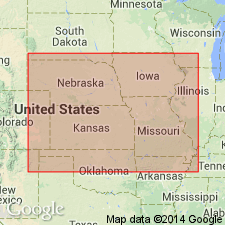
- Usage in publication:
-
- Ervine Creek limestone member*
- Modifications:
-
- Overview
- AAPG geologic province:
-
- Nemaha anticline
- Forest City basin
Summary:
Pg. 2035 (fig. 5). Ervine Creek limestone member of Deer Creek limestone. Uppermost member of Deer Creek; overlies Burroak shale member; underlies Calhoun formation. Age is Late Pennsylvanian (Virgilian). This is classification agreed upon the State Geological Surveys of Iowa, Kansas, Missouri, Nebraska, and Oklahoma, May 1947.
Source: US geologic names lexicon (USGS Bull. 1200, p. 1277).
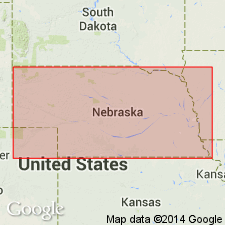
- Usage in publication:
-
- Ervine Creek limestone member*
- Modifications:
-
- Areal extent
- AAPG geologic province:
-
- Nemaha anticline
- Forest City basin
Summary:
Pg. 22. Ervine Creek limestone member of Deer Creek limestone. Member persists from Adair County, Iowa, to Oklahoma. Thickness 14 to 18 feet. Age is Late Pennsylvanian (Virgilian). Type exposures noted.
Type exposures: on Ervine Creek, about 5 mi northeast of Union, Cass Co., southeastern NE.
Source: US geologic names lexicon (USGS Bull. 1200, p. 1277).
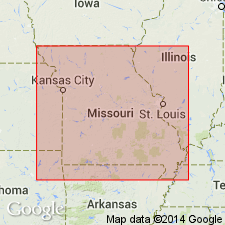
- Usage in publication:
-
- Ervine Creek limestone member
- Modifications:
-
- Contact revised
- AAPG geologic province:
-
- Forest City basin
Summary:
Pg. 17-19, fig. 3. Ervine Creek limestone member of Deer Creek limestone. In Missouri, interval between Rock Bluff limestone member and uppermost limestone of the Deer Creek is occupied by shale. This shale has been treated by Missouri Geol. Survey as occupying the Rock Bluff-Ervine Creek interval, with implication that intervening Haynies limestone is absent in Missouri. This shale interval is here termed [/]Larsh-Burroak. Missouri Geol. Survey recognized the possibility that Burroak shale member may be absent in Missouri and uppermost limestone of Deer Creek formation may include both Haynies and Ervine Creek limestone members.
[The use of a hyphen between undifferentiated [members] is not considered proper notation (CSN, 1933).]
Source: US geologic names lexicon (USGS Bull. 1200, p. 1277).
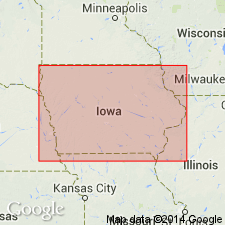
- Usage in publication:
-
- Ervine Creek limestone member
- Modifications:
-
- Areal extent
- AAPG geologic province:
-
- Forest City basin
Summary:
Pg. 17, fig. 5. Ervine Creek limestone member of Deer Creek limestone. Massive- to wavy-bedded fossiliferous light-gray limestone, often chert bearing; algal and oolitic beds near top. Thickness 10 to 14 feet. Overlies Burroak shale member; underlies Calhoun shale. Age is Late Pennsylvanian (Virgilian).
Source: US geologic names lexicon (USGS Bull. 1200, p. 1277).
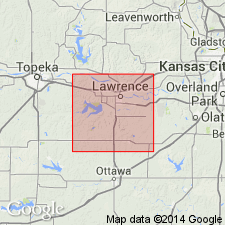
- Usage in publication:
-
- Ervine Creek limestone member
- Modifications:
-
- Overview
- AAPG geologic province:
-
- Forest City basin
Summary:
Pg. 46, pl. 1. Ervine Creek limestone member of Deer Creek limestone. In Douglas County, is 13 to 17 feet thick. Overlies [/]Larsh-Burroak shale member; overlies Calhoun shale. Age is Late Pennsylvanian (Virgilian).
[The use of a hyphen between undifferentiated [members] is not considered proper notation (CSN, 1933).]
Source: US geologic names lexicon (USGS Bull. 1200, p. 1277).
For more information, please contact Nancy Stamm, Geologic Names Committee Secretary.
Asterisk (*) indicates published by U.S. Geological Survey authors.
"No current usage" (†) implies that a name has been abandoned or has fallen into disuse. Former usage and, if known, replacement name given in parentheses ( ).
Slash (/) indicates name conflicts with nomenclatural guidelines (CSN, 1933; ACSN, 1961, 1970; NACSN, 1983, 2005, 2021). May be explained within brackets ([ ]).

